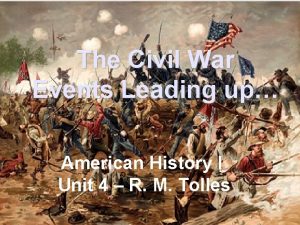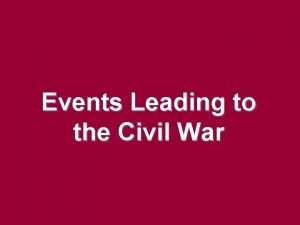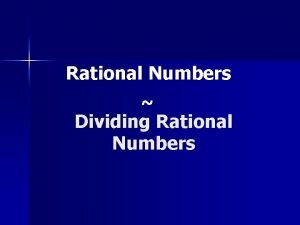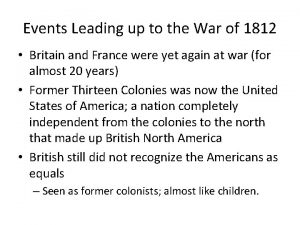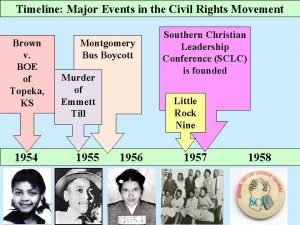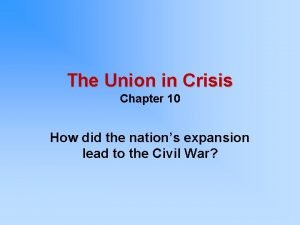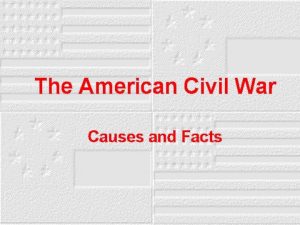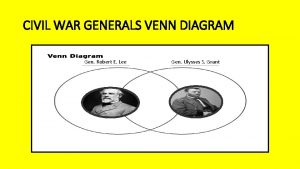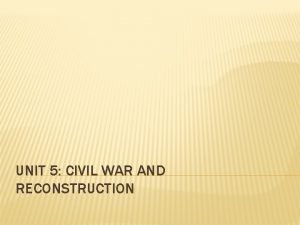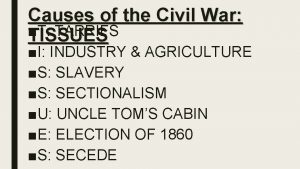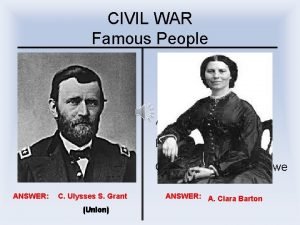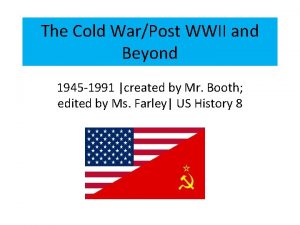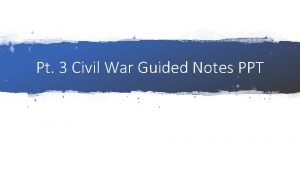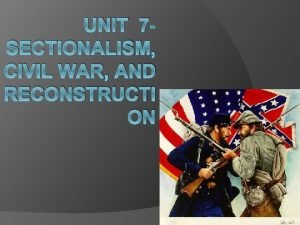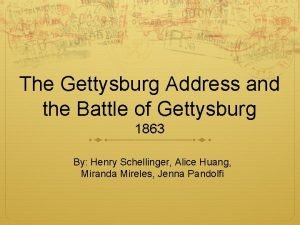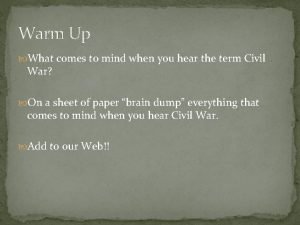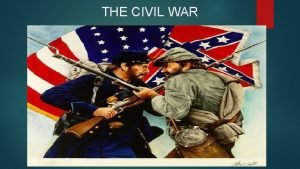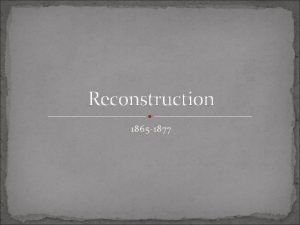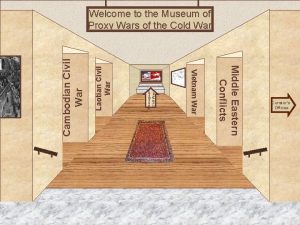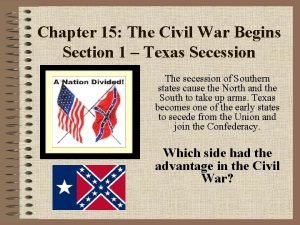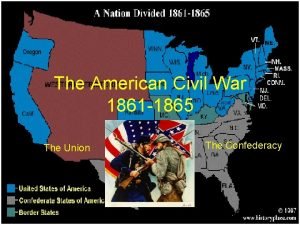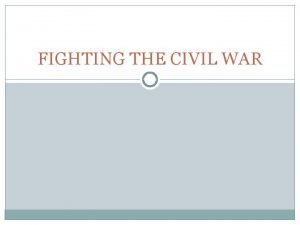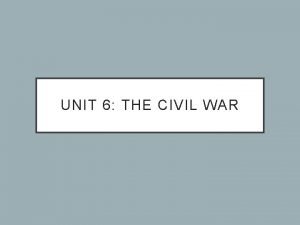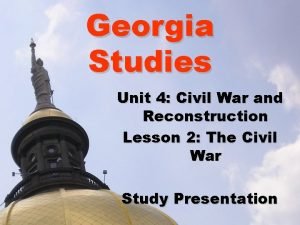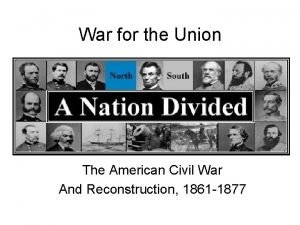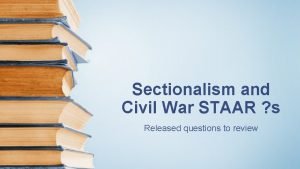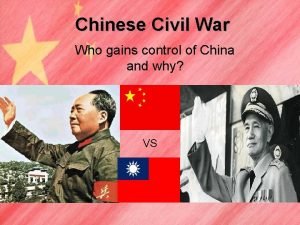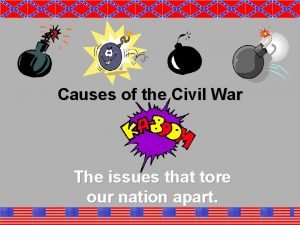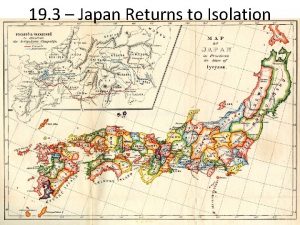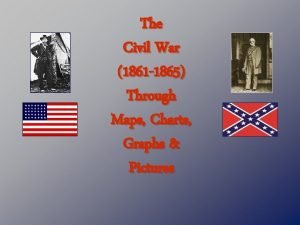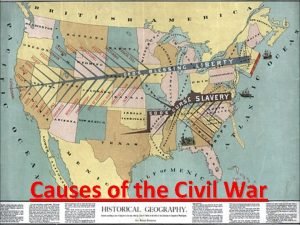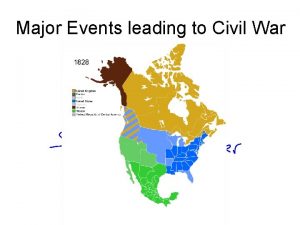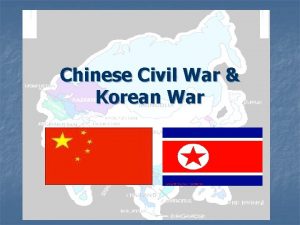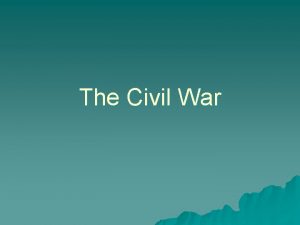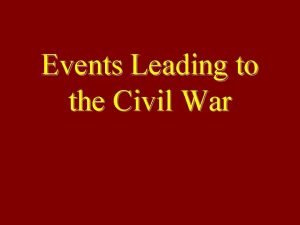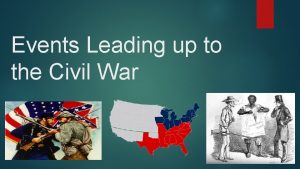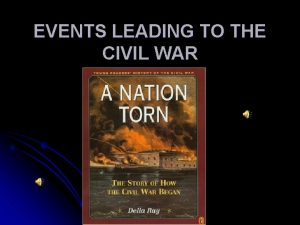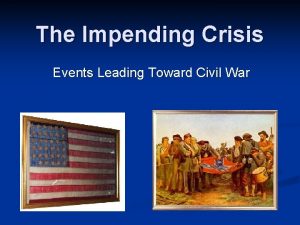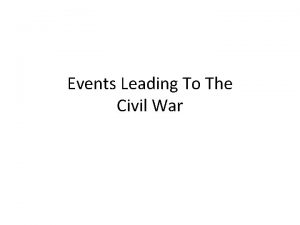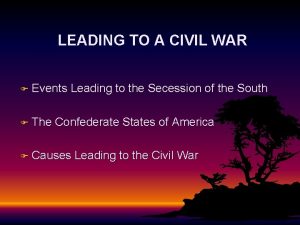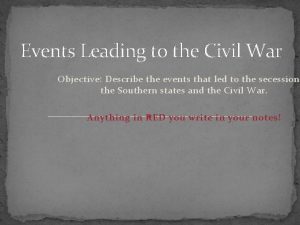Events Leading to the Civil War Dividing the










































- Slides: 42

Events Leading to the Civil War “Dividing the National Map”

3 Causes of the Civil War (3 S’s) • Slavery: During the 1800 s radical abolitionists (mostly in the North) intensified their opposition to slavery at the same time that slavery was becoming even more essential to the economy of the South.

3 Causes of the Civil War • States’ Rights: The old debate over federalism had never really died. Because of its higher population growth, the North would increasingly dominate the federal government. The South responded by claiming that the individual states should have more power to make decisions over issues such as slavery.

3 Causes of the Civil War • Sectionalism: As the North began to industrialize, it became increasingly reliant on wage laborers. As demand for cotton exploded with the creation of the cotton gin, the South became even more reliant on slave labor. The North and South were becoming separate “sections” of the country, each with distinct cultures, economies, and social systems.

Missouri Compromise of 1820 • There were an even number of slave states and free states in the United States. • Missouri was being admitted to the Union as a slave state • No slave states above 36 degrees 30’N • This would disrupt the balance of power in Congress giving the slave states more power. • Maine would come into the U. S. as a free state and Missouri would come in as a slave state.

Significance • This compromise helped keep the peace until 1850. Was it succesful? • Demonstrates how westward expansion would increase tensions between North and South

The Missouri Compromise (1820) ? Free Future Free States Slave Senate= Future Slave States South North State’s Rights Federalism 12 Free 12 Slave Congress bans Slavery in the Louisiana Territory North of Missouri’s southern border. Balance in the Senate is preserved (Missouri=Slave, Maine=Free).

California Divides the Country John C. Calhoun (South Carolina) Daniel Webster (Massachusetts) Henry Clay (Kentucky)

The Compromise of 1850 California? ? California admitted into the Union as a free state. South North State’s Rights Federalism

The Compromise of 1850 The Fugitive Slave Law The Slave Catcher South The Abolitionists! The Fugitive “The Fugitive Slave Law Slave stated that every citizen North Guaranteed the right of southern Congress theand slave holders passes to pursue Fugitive Slave Act. recover their property on State’s Rights Federalism Northern soil. was responsible for helping to recover, The Underground Railroad punish, and return fugitive slaves; so any white person from the North or South could be, and were expected to be, a fugitive slave catcher”.

The Compromise of 1850 Popular Western Slavery ? Question? Territories? Sovereignty Popular Sovereignty: ANorth vote South of the people living in the Western Territories was to be used to decide the State’s Rights Federalism Slavery question.

Provisions of the Compromise of 1850 1) California will be admitted as a free state. 2) Utah and New Mexico may decide on the issue of slavery through popular sovereignty (the voters living in the state will decide whether it enters the Union as a slave state or a free state). 3) The slave trade (though not slavery itself) was banned in Washington, D. C. 4) The Fugitive Slave Act was passed, which forced Northern states to assist in the return of escaped slaves.

Significance of the Compromise of 1850 • Fugitive Slave Act angered many northerners because by law they were forced to help the slave catchers. • Increased tensions between north and south. • Less successful than the Missouri Compromise.

The Abolitionist Movement • 1833, American Anti. Slavery Society was founded to push for abolition of slavery. • 1839, The Society split between Gradualist & Immediatist Factions

Gradualists Lewis Tappan • Gradually phase out slavery… possibly w/ compensation for slave owners. • Done successfully in most northern states. • Would minimize economic disruption. • American & Foreign Antislavery (est. 1840) • Noted Gradualists included… Arthur & Lewis Tappan, James Birney Arthur Tappan

Immediatists • Wanted to immediately end slavery, generally without compensation to slave owners. • Generally employed legal/peaceful methods (speaking tours, newspapers, lobbying, etc. ) “I will be as harsh as truth, and uncompromising as justice. . . I am in earnest, I will not equivocate, I will not excuse, I will not retreat a single inch, and I will be heard. ” -William Lloyd Garrison The Liberator (1831) William Lloyd Garrison “The Liberator”

Other Immediatists Frederick Douglass John Brown Lucretia Mott Fugitive Slave, Abolitionist Speaker, Writer of 3 Autobiographies, Radical Abolitionist Quaker Abolitionist Pottawamie Massacre (1856) Founder of Philadelphia Female Antislavery Society (1833) Editor of antislavery newspaper, The North Star Raid & attempted slave rebellion in Harper’s Ferry , VA (1859) Women’s Rights Leader

Uncle Tom’s Cabin (1852) • Written by the abolitionist Harriet Beecher Stowe. • Told the story of Uncle Tom, an enslaved African American and his cruel master, Simon Legree. • The novel emphasized the cruelty of slavery. • Significance: It helped change the way many northerners felt about slavery. • Slavery was now a moral problem/issue, intensifying anger between the North and South.

South North Harriet Beecher Stowe State’s Rights Federalism Bestselling Focused thebook nation’s written attention by Abolitionist on the evils Harriet of slavery. Beecher Stowe.

Kansas Nebraska Act (1854) popular Sovereignty The issue of slavery would be decided by popular sovereignty.

Kansas Nebraska Act (1854) • Kansas and Nebraska would be divided into 2 territories – Kansas and Nebraska. • The settlers of the new territories would decide (popular sovereignty) whether they would be slave or free. • Significance: Southerners supported the act, while Northerners felt it was a betrayal. Violated the 36 30’ line of the Missouri Compromise. Led to violence in Kansas.

Kansas Nebraska Act “The fifth victim. Border floated Ruffians nearby (Pro as-Slavery) John Brown and his Free Soilers Brown (Anti-Slavery) men washed blood from South Result: “Bleeding Kansas”. Border their swords in Ruffians (Pro-Slavery) and Free Soilers (Anti -Slavery) waged a violent conflict for Pottawatomie control of the territory. State’s Rights Creek. Brown North Video Federalism

Bleeding Kansas • Popular sovereignty led to violence in Kansas. 2 governments were set up in Kansas. One anti-slavery, and one pro-slavery. • Abolitionists flocked to Kansas to try to make it a free state. • Proslavery supporters also crossed over from Missouri to vote for proslavery candidates and harass abolitionists.

Significance of Bleeding Kansas • Shows that popular sovereignty wasn’t an effective way to deal with the slavery issue. • Widespread violence erupted over the issue of slavery. • President Franklin Pierce tried to get Kansas admitted as a slave state but Congress refused. Kansas didn’t come into the Union until 1861 after the war had started. It came in as a free state.

The Beating of Charles Sumner

Beating of Charles Sumner (1856) • Representative Preston Brooks vs. Sen. Charles Sumner (Mass) • Brooks beat Sumner with a cane in Congress in retaliation for a speech Sumner made that advocated Kansas enter the Union as a free state. • Brooks became a hero in the South and Sumner became a martyr in the North. • Represents the breakdown of “reasoned discourse”

Formation of the Republican Party The Republicans were the North South 1856, The name Republican "Republican" Party was In the party of free working white they were opposed to born chosen in the because early 1850's itmen; alluded by anti to Republicans the spread of slavery because they did not want to -slavery equality and reminded activists and became a State’s Rights Federalism compete against unpaid labor in the lands opening in individuals whoofbelieved Thomas national party the West. Theythat were no particular friends of the Jefferson's government should blacks, slave or free. Their when John C. Democraticplan was to gain complete political control in the North; grant western Republican Party. to settlers Fremont was lands if they did, they would have 1856 sufficient electoral strength free of charge. nominated for The. Republicans Party werewas a sectional founded to elect a president. to rather oppose than the aspread national of party. Slavery. President under

A House Divided Speech “ A house divided against itself cannot stand. " I believe this government cannot endure, permanently half slave and half free. I do not expect the Union to be dissolved — I do not expect the house to fall — but I do expect it will cease to be divided. It will become all one thing or all the other. Either the opponents of slavery will arrest the further spread of it, and place it where the public mind shall Northrest in the belief that it is in the course South of ultimate extinction; or its advocates will push it forward, till it shall become alike lawful in all the States, old as well as new — North State’s Rights Federalism Lincoln rose to national prominence with as well as South. ” his famous “House Divided Speech”. 1858

The Dred Scott Case of 1857 They (Slaves) had for more than a century before been regarded as beings of an inferior order, and altogether unfit to associate with the white race, either in social or political relations, and so far unfit that they had no rights which the white man was bound to respect. " — Justice Roger Taney South North The Supreme Also Court ruled that Congress that African-Americans did not have the were right property not State’s Rights Federalism people and therefore to bannot Slavery entitled in to anyconstitutional territory protection.

Significance • The issue of slavery reaches a boiling point. • Dred Scott v. Sanford helped turn slavery into a moral issue in the North and a constitutional issue in the South. • This signaled that there was no more room for compromise between either side.

Lincoln-Douglas Debates 1858 Lincoln and Douglas held a series of debates during the Senate races in 1858. Both were anti-slavery.

John Brown’s Raid on 1859 Brown’s plan was to seize weapons from the Federal Arsenal at Harper’s Ferry to start a Slave revolt in the South. Harper’s Ferry

John Brown’s Raid on 1859 Harper’s Ferry

John Brown’s Raid on After seizing the weapon’s Brown and his men were chased into a small building that became known as John Brown’s Fort. Harper’s Ferry

John Brown’s Raid on Virginia troops seized the fort and arrested Brown. He stood trial in Federal Court for treason against the United States. Harper’s Ferry

John Brown: Hero? To His Execution

John Brown: Villain? To Northerners Brown was a martyred hero, to southerners he was a criminal who deserved his execution. South North State’s Rights Federalism

Brown was hanged at Charles Town on Dec. 2, 1859, with four of his men, after “the crimes of thisaguilty land will never away; handing prophetic note to be hispurged jailer on hisbut waywithto. Blood. " the gallows : "I John Brown am now quite certain that the crimes of this guilty land: will never be purged away; but with Blood. "

Election of Lincoln 1860 South North Lincoln (Republican) wins the presidential election of 1860 Lincoln’s opposition to the spread of Slavery causes many State’s Rights Federalism Southern States to threaten secession from the Union.

Seeing Lincoln’s election as intolerable the Southern States secede from the Union and form the Confederate States of America in 1861. Southern North Secession South Carolina on December 20, 1860 Mississippi on January 9 th, 1861 State’s Rights Federalism Florida on January 10 th, 1861 Alabama on January 11 th, 1861 Georgia on January 19 th, 1861 Louisiana on January 26 th, 1861 Texas on February 1 st, 1861 Virginia on April 17 th, 1861 The Confederate States of America Arkansas on May 6 th, 1861 North Carolina on May 20 th, 1861 Tennessee on June 8 th, 1861 Border Slave States: Delaware Kentucky Maryland Missouri West Virginia 1860 -1861

Fort Sumter Union Actions: No surrender! Do not fire until fired upon. Following a Confederate bombardment, the Union surrenders the fort. The Civil War had begun! Confederate Actions: Surround the Fort and demand surrender. April 12, 1861

The Civil War (1861 -1865)
 Events leading up to the civil war
Events leading up to the civil war What events led to the civil war
What events led to the civil war Chapter 16 lesson 2 challenges to slavery
Chapter 16 lesson 2 challenges to slavery Why was the civil war considered the first modern war
Why was the civil war considered the first modern war Objectives of roving frame
Objectives of roving frame Dividing rational numbers worksheet
Dividing rational numbers worksheet Hamlet climax
Hamlet climax Hamlet act 3 events leading to climax
Hamlet act 3 events leading to climax Leading up to the war of 1812
Leading up to the war of 1812 Civil rights and civil liberties webquest
Civil rights and civil liberties webquest Civil rights timeline of events
Civil rights timeline of events Mutually exclusive events vs not mutually exclusive events
Mutually exclusive events vs not mutually exclusive events Civil war battles
Civil war battles Civil war trading cards project
Civil war trading cards project Civil war facts
Civil war facts Robert e. lee and ulysses s grant venn diagram
Robert e. lee and ulysses s grant venn diagram Who shot john wilkes booth
Who shot john wilkes booth Civil war vocabulary list
Civil war vocabulary list Reconstruction vocabulary words
Reconstruction vocabulary words Tissues causes of civil war
Tissues causes of civil war Civil war and reconstruction study guide
Civil war and reconstruction study guide Famous people in the civil war
Famous people in the civil war Vietnam war at home webquest answers
Vietnam war at home webquest answers Civil war guided notes
Civil war guided notes Quizlet
Quizlet What battle was the turning point of the civil war
What battle was the turning point of the civil war English civil war mind map
English civil war mind map The civil war ended
The civil war ended Aftershock beyond the civil war
Aftershock beyond the civil war Viet cong flag
Viet cong flag States rights
States rights Anaconda plan
Anaconda plan Civil war union strategy
Civil war union strategy Sherman neckties
Sherman neckties Civil war thesis statement
Civil war thesis statement Unit 4: civil war and reconstruction
Unit 4: civil war and reconstruction Civil war usa
Civil war usa Civil war staar questions
Civil war staar questions Who won the chinese civil war
Who won the chinese civil war What are the 3 main causes of the civil war
What are the 3 main causes of the civil war Japan returns to isolation
Japan returns to isolation Civil war 1861/1862
Civil war 1861/1862 Northwest ordinance lead to civil war
Northwest ordinance lead to civil war
